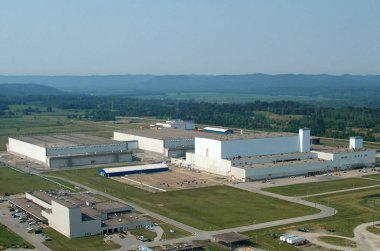US enrichment plant denied loan guarantee
28 July 2009
US enrichment company USEC is preparing to 'demobilise' - or cancel - its partially built uranium enrichment plant after the US Department of Energy (DoE) denied its application for a loan guarantee.
"We are shocked and disappointed by DoE's decision," USEC president and CEO John Welch said in a statement issued after the company was advised of DoE's decision.
 |
| ACP: Spinning to a halt (Image: US) |
The ACP is mid-construction at Piketon, Ohio, using AC100 centrifuge machines developed by USEC from earlier work by the DoE in the 1970s and 1980s. The US Nuclear Regulatory Commission (NRC) granted a construction and operation licence for the plant in April 2007, and the prototype Lead Cascade started operation that September. The plant had been scheduled for commercial operation in 2010, but financing for the plant has long been a concern and earlier this year USEC announced that it was slowing the plant's schedule pending a decision on the DoE loan guarantee.
$1.5 billion already spent
The company applied for loan guarantees amounting to $2 billion in July 2008, but later in the year acknowledged that the success of its application was not assured and said it was evaluating alternative sources of capital. Now, however, the company says it is initiating steps to demobilise the project in which it has already invested $1.5 billion. Demobilisation is likely to involve a partial or full halt to some project activities and plant construction, although the company says it will continue development work on its American Centrifuge technology.
The full plant, with a capacity of 3.8 million SWU (Separative Work
Units, a measure of the energy required to separate uranium-235 from
uranium-238), would have used only 5% of the power of the old gaseous
diffusion enrichment plant it was meant to replace.
No details have yet been given as to why the DoE decided to deny USEC's loan guarantee application. According to Welch, the project met the original intent of the loan guarantee program in that it would have used an innovative but proven technology, reduced greenhouse gas emissions and created thousands of jobs in the USA. "It is unclear how DoE expects to find innovative technologies that assume zero risk," he said, adding that the company was disappointed that commitments to support the application made by President Barack Obama while campaigning had not been honoured.
DoE loan guarantees
Established under the US Energy Policy Act of 2005, the DoE loan guarantee program was set up as a way of helping to drive forward the commercial use of new or improved technologies to sustain economic growth while delivering environmental benefits such as reducing greenhouse gas emissions and providing a stable and secure energy supply. The guarantees reduce the financial uncertainty in employing new power technologies by putting federal backing behind the billions of dollars in loans that companies must take on to finance new energy projects. Should the projects be delayed by government-related issues like safety regulation or planning, the DoE would ensure the company would not have to pay extra finance costs on guaranteed debt.
Eligible projects must employ a new or significantly improved technology that is not yet commercial but has the potential to be used commercially.
Up to $18.5 billion for of loan guarantees are available for the construction of advanced nuclear reactors and up to $2 billion for front-end fuel cycle projects such as enrichment plants. The only front-end projects to submit loan guarantee applications by the September 2008 deadline were USEC's American Centrifuge Plant and Areva's Eagle Rock Enrichment Facility.
The program has made up to $30.5 billion of loan guarantees available to renewable energy and fossil projects. |
The ACP is one of three projects to build new centrifuge enrichment plants in the USA, while GE-Hitachi has applied for a licence to build and operate a laser-based system.
USEC continues to operate its gaseous diffusion enrichment plant at
Paducach in Kentucky, which it says is running at its highest
efficiency ever. The 8 million SWU/yr plant is the only currently
operating commercial enrichment plant in the USA, which has a domestic
enrichment demand of some 12.7 SWU/yr. At the moment, around half US
demand is met from the downblending of highenriched uranium from
decommissioned Russian nuclear weapons.
The National Enrichment Facility (NEF) being built in New Mexico by Louisiana Energy Services (LES), a wholly-owned subsidiary of European enrichment company Urenco, is due to start operations later this year. LES has already announced plans to increase the plant's capacity from the planned 3 million SWU to 5.9 million SWU by 2015. Meanwhile, French nuclear company Areva submitted a licence application to NRC for a 3.3 million SWU/yr centrifuge plant, the Eagle Rock Enrichment Facility, in December 2008 with a view to operation early in 2014. The company has since said it is also planning to double the plant's capacity. Like USEC, Areva has applied for a federal loan guarantee for the $2 billion plant, which would be built in Idaho and owned and operated by Areva Enrichment Services LLC.
Together, the USEC and Areva loan guarantee applications far exceeded the $2 billion set aside for front-end fuel cycle loan guarantees.